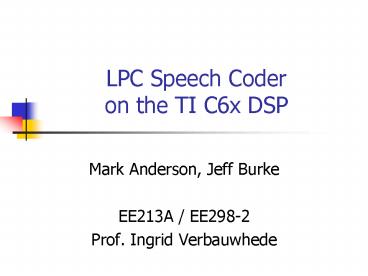LPC Speech Coder on the TI C6x DSP - PowerPoint PPT Presentation
1 / 26
Title:
LPC Speech Coder on the TI C6x DSP
Description:
LPC Speech Coder. on the TI C6x DSP. Mark Anderson, Jeff Burke ... 30-day 'evaluation' license. Draconian copy protection, pulls out the rug from under you ... – PowerPoint PPT presentation
Number of Views:70
Avg rating:3.0/5.0
Title: LPC Speech Coder on the TI C6x DSP
1
LPC Speech Coder on the TI C6x DSP
- Mark Anderson, Jeff Burke
- EE213A / EE298-2
- Prof. Ingrid Verbauwhede
2
Summary
- Implementation platform
- Texas Instruments TMS320C6000
- Low-quantity cost US 35 (C6211)
- Architecture clock frequency
- 150 MHz (C6211)
- Throughput
- 75-80 channels _at_ 8000 samples/sec
3
Summary
- Total energy per sample
- 1.8 uJ/sample
- Area
- 1.2 of cycle budget per chan. per frame
- 8.5 of unified memory per channel
- 25 of unified memory for algorithm
4
Summary
- Flexibility of implementation
- High programmable processor with C compiler, GUI
debugger simulator - SegSNR_A
- ?
- SegSNR_Q
- 26 dB (voiced segments)
5
Architecture overview
- 256-bit VLIW
- Two clustered data paths
- Four functional units in each data path
- 16x16 multiply
- Two ALUs
- Data addressing unit
- 32-bit instruction for each functional unit
- (256 bit instruction for 8 func. Units)
6
Data path diagram
7
Architecture overview
- Split register file
- Only two cross-paths exists
- Cluster is limited to one source read from
opposite register file per cycle. - Data types
- 8, 16, 32-bit with 40-bit accumulate
- 40-bit register pair
8
Memory architecture
- C6211 (US35) has a cache!
- 4kB L1 Instruction cache (L1P)
- 4kB L1 Data cache (L1D)
- 64kB L2 Unified memory and/or cache
- Extra DMA channels
9
Memory architecture
10
Design Tools
- Command-line
- Compiler, debugger, simulator
- Code Composer Studio
- Same tools
- Windows NT GUI
- 30-day evaluation license
- Draconian copy protection, pulls out the rug from
under you
11
Design Flow
- Consolidate Matlab reference into a single
function - Matlab rewritten C-style
- Verified C-style Matlab
- C prototype created
- Imported into Code Composer, optimized simulated
12
Fixed-point quantization
- Input samples
- 16-bit, normalized to -1,1)
- lt1.15gt format used
- Coefficient quantization
- Hamming window, pre-emphasis, FIR
- lt1.15gt format used
- No noticeable change in characteristics
13
Fixed-point quantization
- Most values 16 bit
- Take advantage of 16x16 fast multipliers
- Remain close to other class implementations
- Add metric for overpowered LPC engine
- Use of channels as performance metric
14
Fixed-point quantization
- Energy stored in lt5.27gt
- Prevent overflow, provide precision for low
energy segments - Temporary values stored in lt10.30gt
- Take advantage of extended precision
- Modified autocorrelation used lt16.0gt
- All whole numbers
15
Fixed-Point SNR
- Matlab simulation of magnitude truncation
- Tools again.
- SegSNR_A ?
- SegSNR_Q 26 dB
- Voiced segments only
- Sent_female test data
16
Performance results
- Initial version 80,000 CPU cycles/frame
- Optimization
- Take advantage of VLIW, pipelining
- observe assembly, modify C loops
- Use TIs DSP Library
- Assembly advantage without assembly
- Optimized version 30,182 cycles/frame
- Had to stop early, still at least 5K cycles wasted
17
Performance
- Then, the tool license expired.
- The tool would not install on other machines.
- TI responded, but wasnt too helpful.
- Moral 1 Avoid the evaluation version.
- Moral 2 Give tools away to sell hardware
18
Cycle count details
19
Additional optimizations
- Use more DSPLIB routines
- Autocorrelation
- Assembly-level optimization
- Code size reduction?
- Reduce number of buffers to reduce L1D usage per
frame
20
Energy per sample
- C6211 consumes 1.24W
- 75 high activity / 25 low activity
- 1.24W / 80 channels 15.5mW/channel
- 15.5 mJ/sec/channel 1/8000 1.8 uJ / sample
21
Number of channels
- 150 x 106 cycles/sec x 0.02 sec/frame
- 3.0 x 106 cycles/frame
- 3.0 x 106 cycles/frame / 30,182 cycles
- 99 channels
22
Memory
- C6211 Cache complicates estimates
- Performance is 85-99 of optimal for typical
applications - 30,182 cycles becomes 35,508 cycles/frame for
85 efficiencygt now support only 86 channels
23
Memory
- Try to account for off-chip memory transfers
- 220,000 cycles for 150ns fetches for 80
channelsgt support 75-80 channels - Unable to verify/simulate because of unexpected
tool expiration
24
Memory
- L2 usage
- 16kB Code size thanks to VLIW
- 512 32-byte instruction clusters
- More suited for C6201 larger processors
- Remaining used by data for channels
- 480 bytes each (8.5 of remaining memory)
- L1 usage
- L1P Cant tell because of cache
- L1D 2.2kB (56)
25
Tool comments
- Powerful, easy to use IDE
- When it worked.
- Licensing problems for eval version
- Debugging support a bit odd
- puts/printf
26
C6x Conclusions
- Easily support 75-80 channels of coding
- 26 dB fixed-point SNR, 16-bit types
- VLIW Large code size
- Cache on a low-end DSP!
- Good tools,but draconian copy protection































